F-4EJ Kai Phantom II
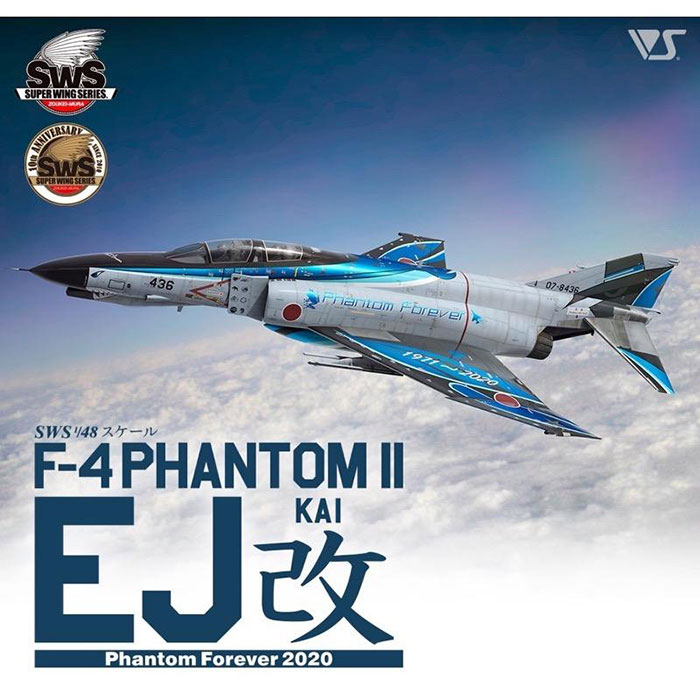
Zoukei-Mura, 1/48 scale
S u m m a r y |
| Item No. |
Zoukei-Mura Super Wing Series No.11 - F-4EJ Kai Phantom II |
| Contents and Media: |
419 parts in grey plastic; 15 parts in clear; two A4-sized decal sheets. |
| Scale |
1/48 |
| Price: |
7,480 yen (6,800 excluding tax) available for pre-order with special offers from Volks Japan's web store. Pre-order offers open until 13 December 2020 |
| Review Type: |
FirstLook |
| Advantages: |
Gorgeous crisp surface textures; very high level of detail; full weapons fit; clear instructions; versatile contents will allow you to also build an early F-4EJ or a hard-wing early F-4E Phantom II. |
| Disadvantages: |
No harness straps for ejection seats. |
| Recommendation: |
Zoukei-Mura's 1/48 scale F-4EJ Kai Phantom II is a gorgeous kit. Surface textures are world class and detail is excellent. Options are comprehensive too. Almost anything that opens and shuts on the rear aircraft may be posed on the model. Having owned the Hasegawa and Academy 1/48 scale kits, I can confidently declare that Zoukei-Mura's is the best of the bunch. However, this is no weekend build. The sheer parts counts and relative complexity means that you'll need to allocate plenty of time to double check the big instruction booklet and test fit regularly. With care and patience though, you'll have a very striking 1/48 scale Phantom! |
Reviewed
by Brett Green

The F-4EJ was a simplified F-4E exported to and license-built in Japan.
From 1968, the Japan Air Self-Defense Force (JASDF) purchased a total of 140 F-4EJ Phantoms without aerial refuelling, AGM-12 Bullpup missile system, nuclear control system or ground attack capabilities.
Mitsubishi built 138 under license in Japan and 14 unarmed reconnaissance RF-4Es were imported. One of the aircraft (17-8440) was the last of the 5,195 F-4 Phantoms to be produced. It was manufactured by Mitsubishi Heavy Industries on 21 May 1981. "The Final Phantom" served with 306th Tactical Fighter Squadron and later transferred to the 301st Tactical Fighter Squadron.
Of these, 96 F-4EJs were modified to the F-4EJ Kai standard. F-4EJ Kai was the designation applied to existing Japanese-built F-4EJ fighters that were upgraded in a modernization program initiated in July of 1984. The goals of the program were to bring JASDF F-4EJs up to standards appropriate for the 1990s and to extend their service lives well into the 21st century.
15 F-4EJ and F-4EJ Kai were converted to reconnaissance aircraft designated RF-4EJ.
Japan had a fleet of 90 F-4s in service in 2007. After studying several replacement fighters, the F-35 Lightning II was chosen in 2011. The 302nd Tactical Fighter Squadron became the first JASDF F-35 Squadron at Misawa Air Base when it converted from the F-4EJ Kai on 29 March 2019.
The JASDF's sole aerial reconnaissance unit, the 501st Tactical Reconnaissance Squadron, retired their RF-4Es and RF-4EJs on 9 March 2020, and the unit itself dissolved on 26 March. The 301st Tactical Fighter Squadron is now the sole user of the F-4EJ in the Air Defense Command, with their retirement scheduled in 2021 along with the unit's transition to the F-35A.
Some F-4s are also operated by the Air Development and Test Wing in Gifu Prefecture.*
Zoukei-Mura lanched their 1/48 scale Phantom family in 2016 with an F-4J. In the menatime, they have released a number of other variants including F-4S, F-4C, F-4D and most recently an early version F-4E Phantom II.
It would be logical to follow a hard-wing early version F-4E with the Japanese F-4EJ version, as the types shared a lot in common.
It is therefore no surprise to see that Zoukei-Mura's next release will be an F-4Ej Kai.
We are fortunate to have been sent an advance copy of the sprues and a photocopy of the instructions for this kit, due to be released later this year.
Zoukei-Mura's new 1/48 scale F-4EJ Kai comprises 419 parts in grey plastic (including 124 marked not for use); 15 parts in clear; and two A4-sized decal sheets.
The first impression after opening the large, deep box is the quality of the medium grey coloured plastic. It is neither too brittle nor too soft - reminiscent of Tamiya plastic. Surface textures are world class too, comprising crisply recessed panel lines and selected rows of rivets and fasteners. Sprue attachment points are fine and should require only minimal cleanup.
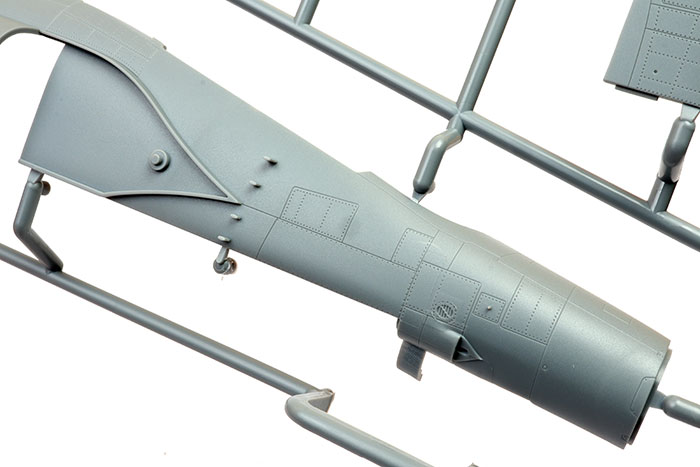
I was particularly impressed with the textures on the empennage hot areas.
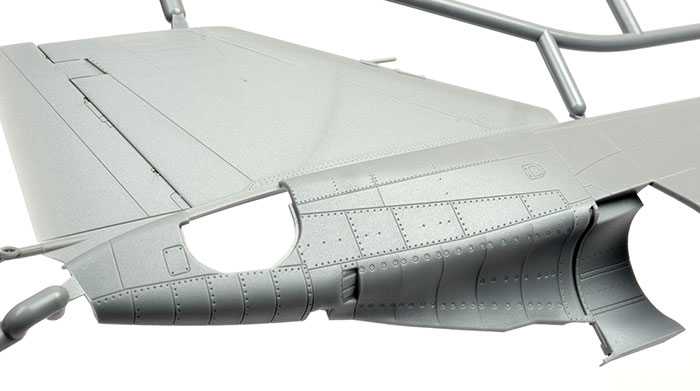
The kit is all plastic - no photo-etch or other multimedia components here - although I am sure that it is only a matter of time until after-market updates will be released.
This kit appears to contain all the previously released sprues from the early version F-4E Phantom II. These will allow you to build either a USAF early F-4E or an early version F-4EJ.
There is also has one additional sprue with all the parts needed to model a Japanese-built F-4EJ Kai upgrade.
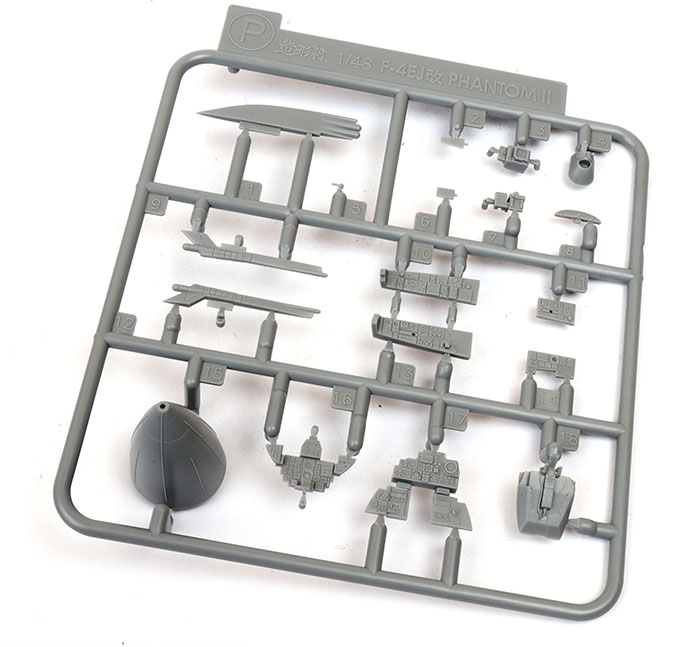
This relatively small sprue offers a comprehensive range of F-4EJ Kai upgrades, including:
-
Fin tip: Changed to J/APR-6 antennas (JASDF-exclusive antennas).
-
Fuselage spine antenna: Changed from UHF antenna to V/UHF antenna.
-
Center of the rear seat: Added lower monitor.
-
Tailcone popup door: Added tail light.
-
Changed lever for rear seat right-side console.
-
Undercarriage door antenna: Added V/UHF antenna.]Added instruments to rear seat side console.
-
Central canopy divider: Changed shape of seat separation panel.
-
Left wing tip: Changed to J/APR-6 antenna (JASDF-exclusive antenna).
-
Front seat right-side console: Changed instrument layout, including switches.
-
Rear seat left-side console: Changed instrument layout, including switches.
-
Right wing tip: Changed to J/APR-6 antenna (JASDF-exclusive antenna).
-
Front seat left-side console: Changed instrument layout, including switches.
-
Rear seat right-side console: Changed instrument layout, including switches. Attached “5. lever for rear seat right-side console”.
-
Nose radome: Added a total of seven lightning strips (static dischargers).
-
Front seat instrument panel: Changed instrument layout, including switches.
-
Rear seat instrument panel: Changed instrument layout, including switches, added “3. centre of the rear seat lower monitor”.
-
Anti-glare shield: The F-4EJ Kai uses a Kaiser HUD instead of the F-4EJ’s optical sight,. Therefore the base for “20. Combiner (parts 6 and 7 on the clear L sprue)” is shown in the moulding. **
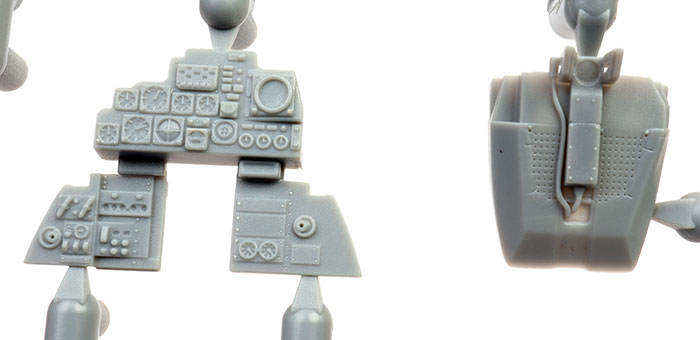
A number of additional options are included on the other sprues too. Check out Zoukei-Mura's website for more details.
The overall parts breakdown is fairly conventional with full-length fuselage halves, centre lower wing (non-slatted hard wing) with sections of the forward and rear lower fuselage moulded in place, separate outer wing panels and upper wing halves.
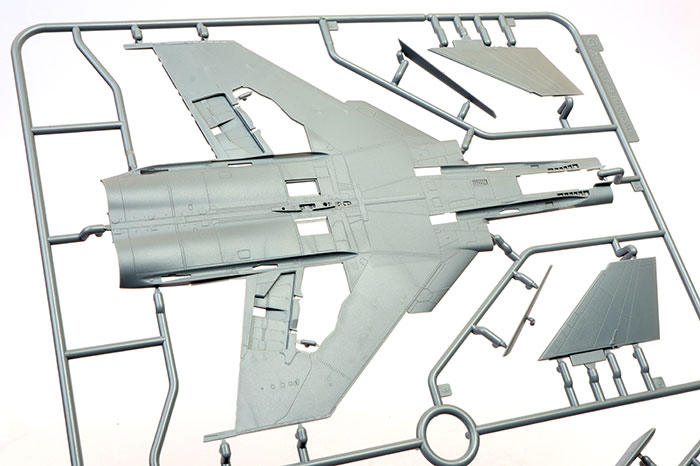
Leading edge slats and the flaps may be posed dropped or closed. I like the method used to pose the flaps. There are two sets of tabs on each flap. Simply cut off the pair that you don't want depending on whether the flaps are posed up or down.

The stabiliators may be posed to taste and the fin tip is a separate part. Air brakes are separate parts that may also be posed open or closed.
Construction commences in the cockpit. Detail is excellent, with raised bezel and switch detail on the instrument panels and side consoles. The only shortcoming is that the seats do not have any harness straps, so you're on your own there.
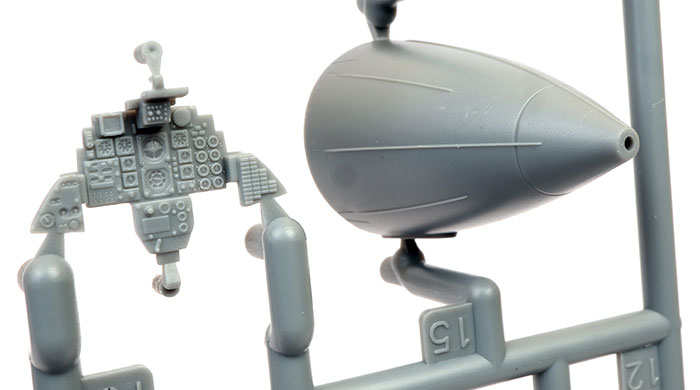
The floor of the cockpit doubles as the roof of the nose gear bay. This is also beautifully detailed with structural detail moulded in place.
The main undercarriage bays look great too. They are made up from the inside of the upper wing for the ceiling, and a cleverly moulded single part that depicts the sidewalls.
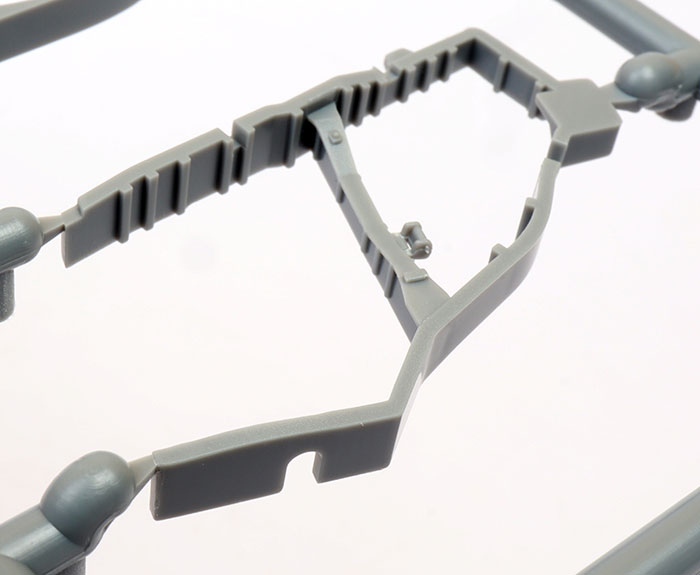
Full engine and ducting detail is supplied.
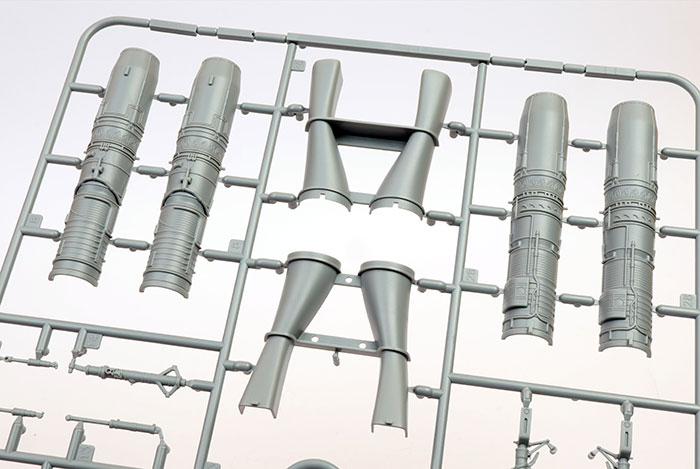
Parts are provided to depict the nozzles open or closed.

Clear parts are thin and free from distortion. Zoukei-Mura supplies two entire canopies - one closed version moulded in a single piece and an open version with separate windscreen and separate opening canopy sections. Navigation lights and gunsight reflectors are also included on the clear sprue.

A big selection of underwing ordnance, drop tanks and mounts are included.
You'll have plenty of extras for your spares box!
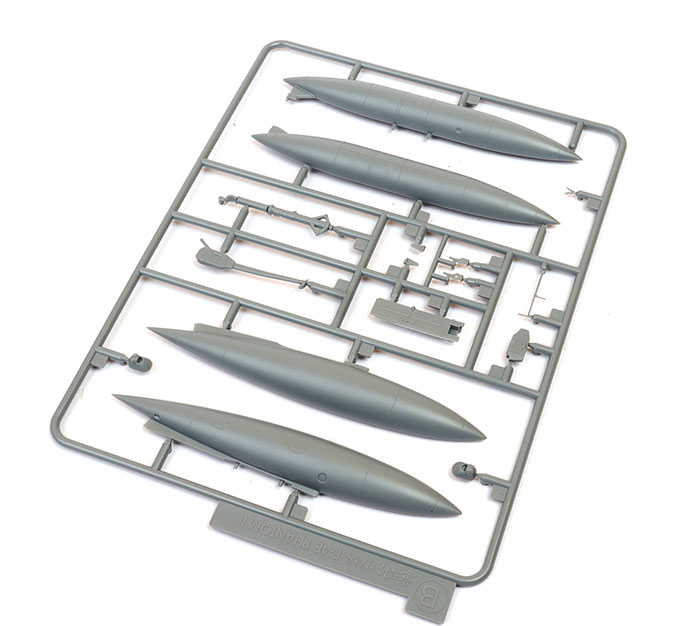
Instructions are supplied on a big 30 page booklet. In fact, it's almost too big to be called a booklet. Parts numbers, labels, cross-reference and colour call outs all accompany the 38 steps of assembly diagrams. It's pretty busy on the pages so I suggest that you thoroughly acquaint yourself with the booklet before you start cutting parts from the sprues.
Markings
Markings are supplied for a single commemorative aircraft.

This is an F-4EJ Kai 07-8436 "Phantom Forever 2020" 301 Sqn. Hyakuri AB 2020.
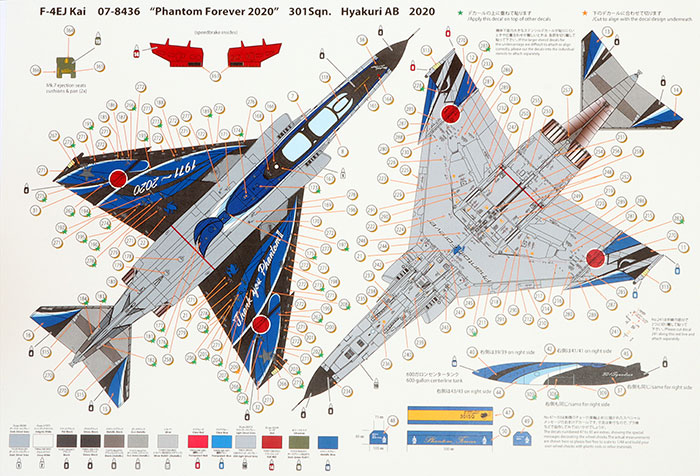
The markings are supplied on two large A4-sized decal sheets.
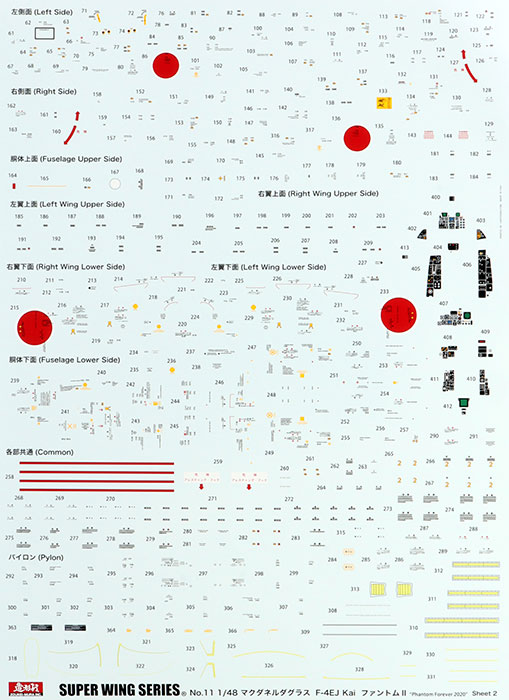
Colours look perfectly saturated and in register.
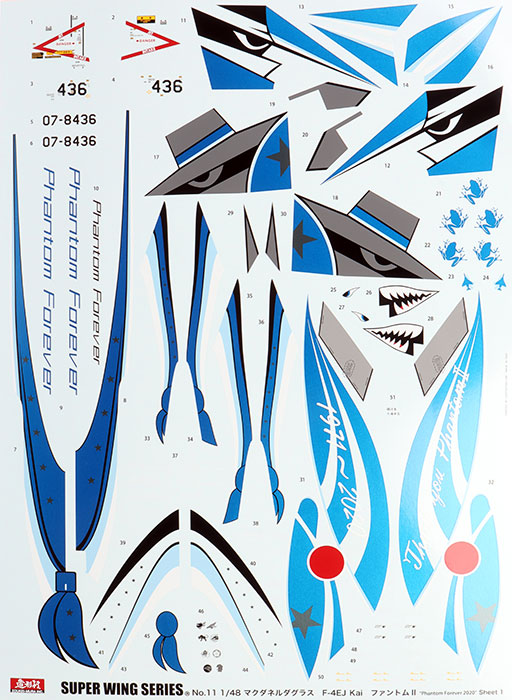
The blues are amazing. They appear to be properly metallic in finish.
Zoukei-Mura's 1/48 scale F-4EJ Kai Phantom II is a gorgeous kit. Surface textures are world class and detail is excellent.
Options are comprehensive too. Almost anything that opens and shuts on the rear aircraft may be posed on the model.
Having owned the Hasegawa and Academy 1/48 scale kits, I can confidently declare that Zoukei-Mura's is the best of the bunch.
However, this is no weekend build. The sheer parts counts and relative complexity means that you'll need to allocate plenty of time to double check the big instruction booklet and test fit regularly.
With care and patience though, you'll have a very striking 1/48 scale Phantom!
* Historical summary courtesy of Wikipedia
** Summary of additional parts courtesy of Zoukei-Mura's website
Thanks to Zoukei-Mura for the samples
Review Text and Images Copyright © 2020 by Brett Green
Page Created 9 November, 2020
Last updated
10 December, 2020
Back to HyperScale Main Page
Back to Reviews Page
|
Home
| What's New |
Features |
Gallery |
Reviews |
Reference |
Forum |
Search